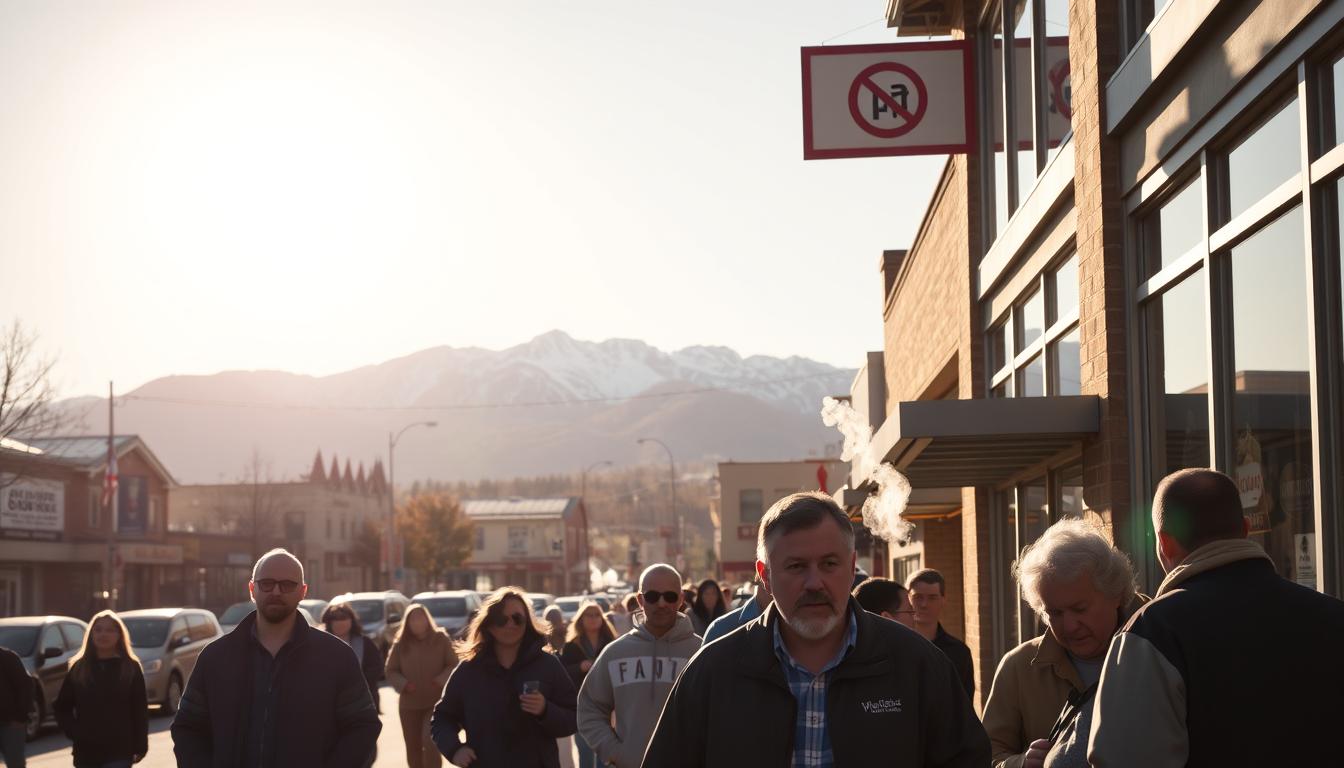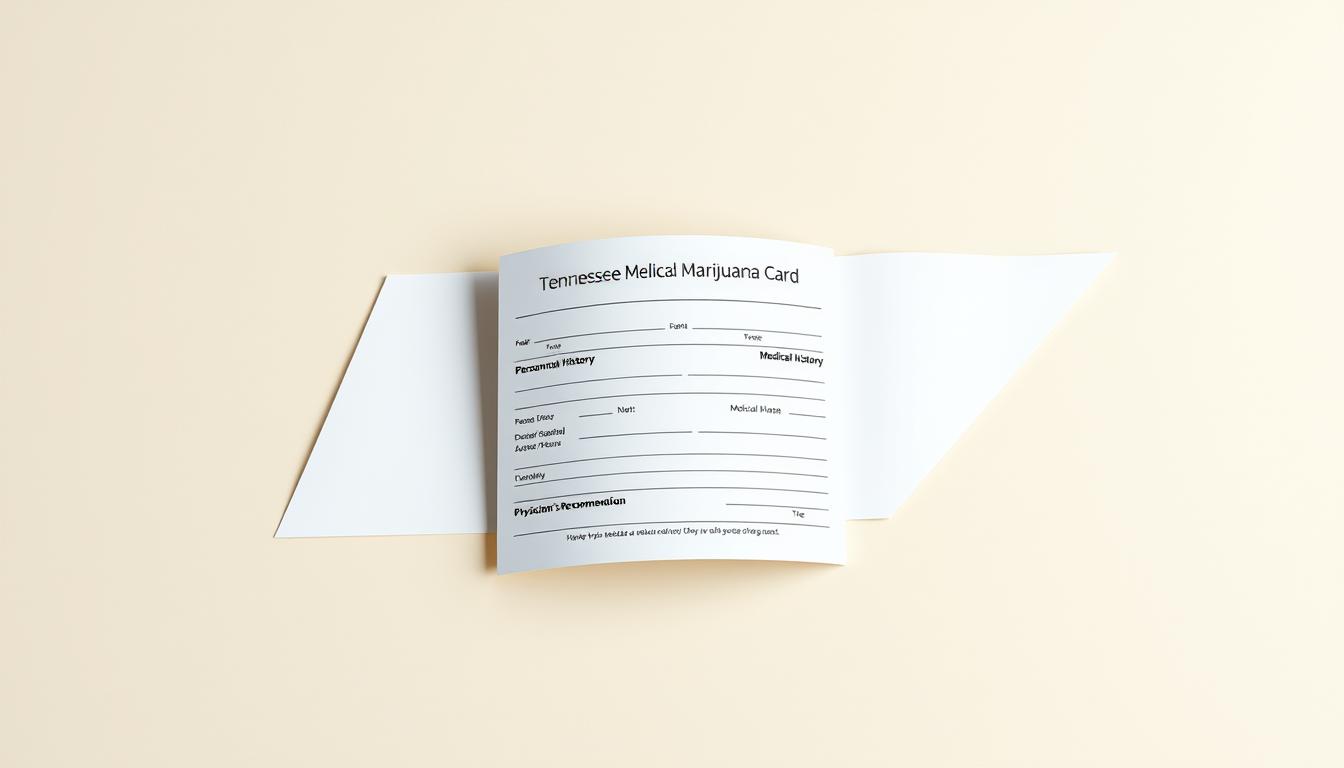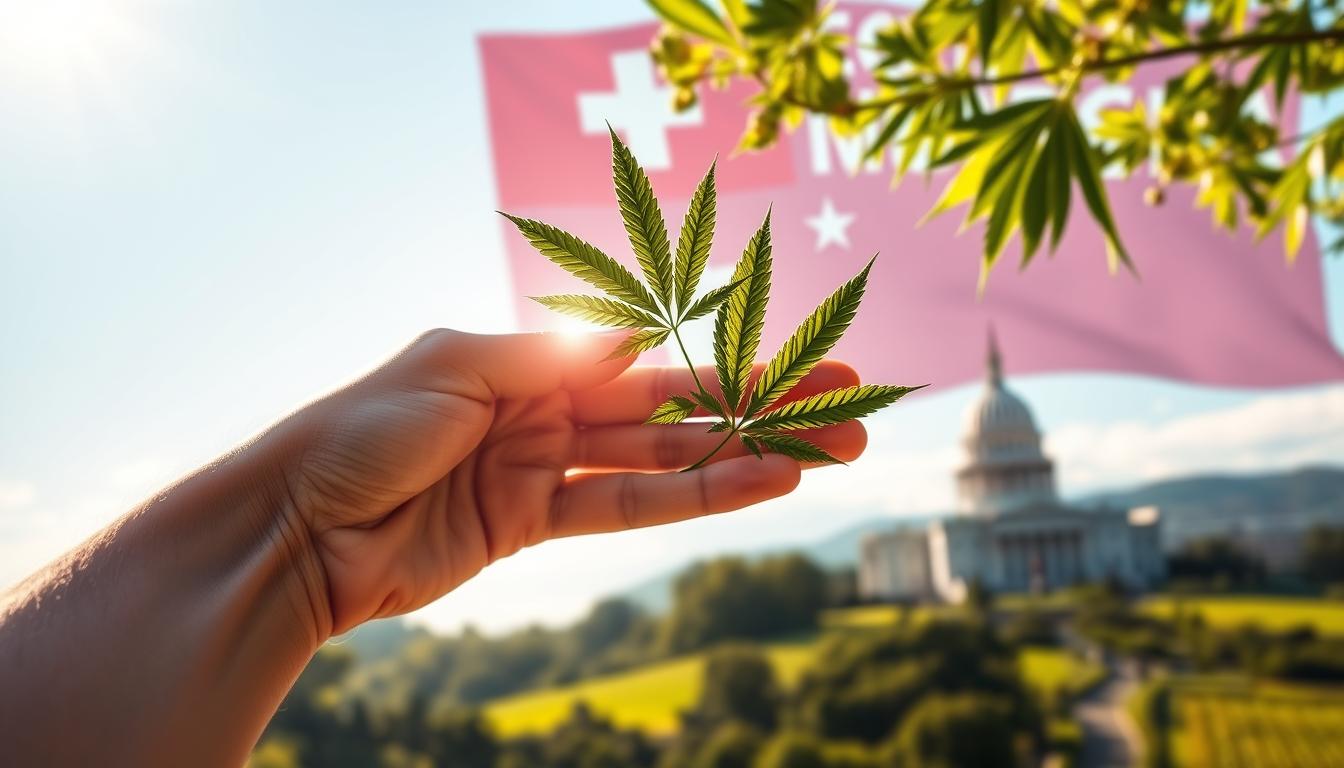Is it legal to smoke in public in Alaska?. Alaska is famous for its huge wilderness and forward-thinking views on many topics. It has made big moves to keep its people and visitors healthy. One key step is the Smokefree Alaska Law, aimed at keeping public and work areas smoke-free.
The Smokefree Alaska Law (AS18.35.300 –18.35.399) started on October 1, 2018. It bans smoking and vaping in places where people work and gather. This change is a big step towards a healthier place for everyone.
Knowing Alaska’s smoking laws helps people move around safely. It makes sure everyone follows the rules to keep everyone’s health safe.
Overview of Smoking Laws in Alaska
Smoking laws in Alaska have changed a lot over time. They aim to protect people from the dangers of smoking and secondhand smoke.
Definition of Public Smoking
In Alaska, public smoking means smoking or vaping in places open to everyone. This includes indoor and outdoor public places like malls, restaurants, and buses. It also covers e-cigarettes, vape pens, and e-hookahs, even if they don’t have nicotine.
Recent Changes to the Law
Alaska’s laws now cover e-cigarettes and vaping products too. These updates help fight nicotine addiction and cut down on secondhand smoke. Businesses and public places must follow these rules to keep everyone healthy.
The Alaska smoking ban has strict rules and penalties for breaking them. This shows Alaska’s strong effort to lower smoking-related health risks.
Federal Regulations on Smoking
It’s important to know the federal laws about smoking in Alaska. These laws help shape the rules for smoking in public places.
The Tobacco Control Act
The Tobacco Control Act gives the FDA power to control tobacco. It has helped cut down tobacco use, mainly among young people. It does this by limiting how tobacco can be marketed and sold.
This act makes it illegal to sell tobacco to minors. It also stops tobacco ads. One big part of the act is the need for graphic warning labels on cigarettes. These labels aim to warn people about smoking’s health dangers. The FDA can also check new tobacco products and ban harmful ingredients.
Restrictions for Federal Properties
Smoking is banned in national parks and government buildings. This rule helps keep everyone safe from secondhand smoke. It also makes these places healthier. Alaska state law also limits smoking in public places, following federal rules.
These rules are strict to keep places smoke-free. Breaking them can lead to fines. This shows how serious it is to follow these rules.
Following federal smoking laws helps make Alaska a healthier place. These laws, along with state and local rules, create a strong system to control tobacco in Alaska.
State Laws Regarding Public Smoking
Alaska’s smoking laws are detailed in the state’s statutes and regulations. Smoking is banned in enclosed public areas. This includes entertainment venues, sports arenas, public transportation, and government buildings.
Alaska Statutes on Smoking in Public Areas
Alaska Statutes clearly state where smoking is not allowed. This includes enclosed public places like restaurants, bars, and malls. It also covers public transportation and government buildings.
The laws aim to protect people from secondhand smoke. By banning smoking in these areas, Alaska works to make public spaces healthier for everyone.
Enforcement of State Smoking Laws
It’s important for Alaska’s smoking laws to be enforced. Local authorities are in charge of making sure these laws are followed.
Business owners also play a key role. They must post no-smoking signs and keep their places smoke-free.
- Local authorities are responsible for enforcing the laws.
- Business owners must comply with the regulations.
- Signage indicating no-smoking areas is required.
Designated Smoking Areas
The state of Alaska has laws about designated smoking areas. These laws help keep everyone healthy while also respecting smokers’ rights.
In Alaska, you can smoke in certain places. These include:
- Outdoor areas that are not enclosed and are far enough from buildings to keep smoke out.
- Certain stores that sell tobacco or e-cigarettes, under specific rules.
- Private homes, unless they are used for business like childcare or healthcare.
Locations Where Smoking is Permitted
Smoking is okay in some outdoor spots, as long as they meet Alaska’s rules. For example, you can smoke outside bars and restaurants if they have good ventilation and follow state laws. For more info on Alaska’s smoking laws, check the Alaska State Legislature’s website.
Responsibilities of Business Owners
Business owners in Alaska must follow the state’s smoking rules. This means:
- Putting up clear no-smoking signs where it’s not allowed.
- Making sure smoking areas meet state rules for air and distance from public areas.
- Working with police and health officials to enforce smoking laws.
By following these rules, business owners help make a healthier place for everyone.
Municipal Regulations on Smoking
Smoking laws in Alaska come from both state and local rules. This setup lets each area handle smoking rules in its own way. It shows how different places in Alaska have their own needs and wishes.
Overview of Local Ordinances
Local areas in Alaska can make their own smoking rules. For example, Anchorage has a rule, AMC 16.65, that bans smoking in public places. This rule was made in 2006 to cut down on secondhand smoke and make places healthier for everyone.
Different places in Alaska have different rules about smoking. This shows why it’s key to know the local rules about smoking in public places.
Impact of City Policies on Public Smoking
City policies on smoking really affect how people act and their health. By making places smoke-free and enforcing rules, cities can lower smoking rates and secondhand smoke exposure.
Key effects of municipal smoking regulations include:
- Reduced incidence of smoking-related illnesses
- Decreased exposure to secondhand smoke in public places
- Changes in social norms regarding smoking behavior
These results are important for creating a healthier environment. They show how local governments play a big part in keeping people healthy.
Exceptions to General Smoking Laws
Alaska has strict smoking bans, but there are some exceptions. These rules are important for both smokers and non-smokers to know. They help everyone understand the state’s smoking laws better.
Smoking in Parks and Recreational Areas
Smoking is mostly banned in public parks and areas where kids play. For example, smoking is not allowed within 10 feet of playgrounds at schools or parks when kids are around. This rule helps keep kids safe from secondhand smoke.
Special Events and Smoking Permissions
At special events like festivals, the smoking rules can be different. Event organizers might get permission to have smoking areas. But, these permissions depend on local laws and health rules.
Event planners need to follow Alaska’s smoking laws and get the right permits. The rules for smoking at events can change a lot, based on where and what kind of event it is.
- Event organizers must check with local authorities for specific smoking regulations.
- Smoking areas must be clearly designated and comply with state and local laws.
- Permissions for smoking at events are typically granted on a case-by-case basis.
Health Considerations Related to Smoking in Public
In Alaska, smoking in public is a big health worry. Laws aim to protect everyone’s health while respecting personal freedom. Smoking in public can harm smokers and those around them.
The Smokefree Alaska Law helps keep people safe from secondhand smoke. It’s part of a bigger effort to lessen smoking’s health effects in public.
Secondhand Smoke Exposure
Secondhand smoke is a major health risk. It has hundreds of harmful chemicals, many linked to cancer. Alaska works hard to lower this risk, focusing on kids and workers in smoking-heavy areas.
Secondhand smoke can lead to lung cancer, heart disease, and breathing problems. Alaska’s laws aim to cut these risks. They aim to make public spaces healthier for everyone.
Public Health Campaigns Against Smoking
Health campaigns are key in Alaska’s fight against smoking. They use education and outreach to teach about smoking’s dangers and quitting’s benefits.
These efforts have helped lower smoking rates in Alaska. Alaska’s laws and campaigns work together to tackle smoking’s health risks.
- Reducing secondhand smoke exposure in public places
- Promoting smoking cessation programs
- Educating the public about the health risks associated with smoking
Alaska keeps moving forward in reducing smoking’s health effects. They work to make a healthier place for everyone.
Cultural Attitudes Toward Smoking in Alaska
To understand Alaska’s views on smoking, we must look at its history and culture. The state’s indigenous roots, its frontier past, and its modern culture shape these views.
Historical Context of Smoking in Alaska
Smoking has long been part of Alaska’s culture, mainly in indigenous communities. Tobacco was used in ceremonies and rituals. The arrival of commercial tobacco changed things, making it more common and altering its cultural role.
The history of smoking in Alaska is complex. Tobacco’s role varied across cultures. For some Native American groups, it was sacred, used in spiritual and medicinal ways.
Current Trends and Public Opinion
Today, Alaska’s views on smoking blend old traditions with new health concerns. While some see smoking as part of their culture, many now know its health risks.
Opinions on smoking in Alaska vary. Some want stricter public smoking rules in Alaska for health reasons. Others want to keep cultural tobacco practices alive. This debate mirrors national discussions on freedom versus health.
- There is a growing trend toward stricter smoking regulations in public places.
- Public health campaigns are increasingly focusing on the dangers of secondhand smoke.
- Cultural sensitivity is being considered in the development of smoking laws and regulations.
The question of is it legal to smoke in public in Alaska? is complex. It shows the state’s diverse views and the ongoing debate between health and individual rights.
Legal Consequences of Smoking Violations
Breaking Alaska’s smoking rules can lead to big legal troubles. It affects both people and businesses. The state’s strict laws are to keep everyone healthy, and breaking them can mean big fines.
Fines and Penalties
People caught smoking where they shouldn’t can get fines from $100 to $500. This depends on where they were and how bad it was. Businesses that don’t follow the rules can get fined too. They might even lose their licenses.
- First-time offenders might just get a warning or a small fine.
- Those who keep breaking the rules will face harsher penalties.
- Businesses must make sure their employees and customers follow the rules.
Legal Recourse for Businesses
Businesses that think they were unfairly fined can seek legal help. They can appeal the fine through the right legal steps.
It’s key for everyone to know Alaska smoking laws and Smoking restrictions in Alaska. This helps avoid legal problems. By following these rules, Alaskans help make the state healthier for all.
Smoking and Native Alaskan Communities
In Alaska, the mix of traditional tobacco use and modern smoking laws is complex. This is true, mainly in Native communities. Tobacco’s deep cultural meaning affects both old traditions and new laws.
Traditional Uses of Tobacco
Tobacco has been key in Native Alaskan culture for ages. It’s used in many traditional ways and in ceremonies. Its role goes beyond just smoking, playing a big part in spiritual and cultural events.
- Ceremonial use in spiritual practices
- Traditional healing practices
- Cultural storytelling and passing down traditions
Cultural Sensitivity in Smoking Laws
When making smoking rules in Alaska, it’s vital to think about tobacco’s cultural role in Native communities. It’s about finding a balance. We need to protect health while also honoring cultural traditions.
Some important things to consider are:
- Exemptions for traditional and cultural uses of tobacco
- Education and outreach programs tailored to Native communities
- Collaboration with Native Alaskan leaders in making smoking rules
By being culturally aware, Alaska can make effective smoking regulations. These rules will respect Native Alaskan traditions and help public health.
Resources for Smokers and Non-Smokers
In Alaska, there are many resources for those who want to quit smoking or need legal help. It can be hard to understand smoking laws, but there’s support to help you. This makes it easier to follow these rules.
For those trying to stop smoking, Alaska has many programs. These smoking cessation programs offer counseling and medication to fight nicotine addiction. They also have support groups where people can share their struggles and get support from others.
Smoking Cessation Programs
Alaska’s smoking cessation programs tackle both the physical and mental sides of nicotine addiction. These programs are often free or very affordable. This makes them available to many people.
Participants get personalized advice and support. This increases their chances of quitting smoking for good.
Legal Assistance for Smokers
For legal help on smoking issues, GAPs Alaska is a great resource. They give info on Alaska’s smoking laws and help with legal problems.
Both smokers and non-smokers in Alaska can learn about their rights and duties under the state’s smoking laws. Whether you’re quitting or dealing with legal issues, there’s support to guide you.
Conclusion: The Future of Smoking in Public in Alaska
Alaska is figuring out its smoking laws, and it’s a big deal. The state has banned smoking in public places to cut down on smoking. But, the question is: Can you smoke outside in Alaska? The answer depends on the law and the efforts to change it.
Potential Changes to Legislation
Alaska might make its smoking laws even stricter. This could make smoking in public areas harder to do. Changes could come from health campaigns and people speaking up for their rights.
Community Advocacy
Community voices are key in shaping Alaska’s smoking rules. By talking to lawmakers and joining public discussions, people can influence the laws. This way, the rules can better match what Alaskans want and need.


